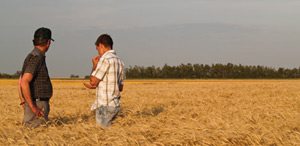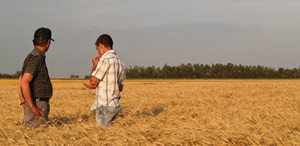
Study shows more western Canadian wheat growers are buying certified seed.
A recent study completed by Blacksheep Strategy revealed a shift towards increased certified wheat seed usage in Western Canada. This is welcome news for Canadian seed growers.
“The expectation that more wheat farmers will be using certified seed in the future is certainly a positive outcome for seed growers in Canada,” says Dale Adolphe, executive director of the Canadian Seed Growers’ Association.
This past December, Blacksheep Strategy, a Canadian brand and research consultancy, surveyed 600 wheat growers from across Western Canada on changing farm business practices in wheat technology. The farmers were randomly selected; however, those surveyed had to produce a minimum of 200 acres of wheat.
“We chose that criteria because, when we looked at the last census of agriculture, farmers with a minimum of 200 acres of wheat covered 93 per cent of all the wheat acres, so that’s giving us great coverage of all the acres out there, although it is only two-thirds of all the growers,” says Joanna Karman, business strategist for Blacksheep Strategy.
The growers were asked to discuss their current and evolving certified spring wheat seed practices, as well as selecting and purchasing wheat seed in the predominant CWRS class. The survey consisted of questions in five general areas: the farmers’ behaviours around certified seed usage; their channel preferences; the timing of their decision making; the importance of variety characteristics; and variety awareness.
Respondents indicated that their certified seed usage is increasing, and a growing number of them are purchasing new certified seed annually for all of their acres. “It was quite a remarkable increase in terms of looking at some of the past behaviour,” says Karman. “But it’s not anywhere near the canola seed market, where almost all the seed that’s used is certified.”
The rise in certified wheat seed usage may be attributed to introduction of new varieties with improved yield and disease resistance. “These are the kinds of characteristics that farmers are looking for, and they contribute to the farmers’ interest in replacing some of the older varieties with something newer that performs better,” says Karman.
Farmers may also be more interested in using certified seed this year because of last year’s poor growing conditions. “The farmers’ own seed, in terms of quality, may have been substandard given last year’s growing conditions, so that may be driving some intentions to purchase certified seed,” says Karman, noting the wheat seed market can be broken down into a few buyer segments: infrequent buyers who comprise the bulk of the market; occasional buyers; and annual buyers, who make up the segment that’s growing.
“We’re interested in the yearly buyers. This is the segment that has the same behaviour as the canola seed segment, and this is the segment that’s growing. So that’s the evidence that the market is shifting towards greater adoption overall of certified wheat seed,” says Karman.
Buying Patterns
In the study, Karman also noticed differences between provinces. Farmers in each province are looking for different seed attributes, so it’s a more fragmented market, she says. However, the research didn’t reveal any differences based on the size of farm. Karman thought she might see some evidence appear along the lines of small farmers versus large farmers, but the only thing she noticed is that when purchases are made, smaller farmers will tend to buy seed for all their wheat acres and larger farmers will buy for a only a portion.
Farmers continue to purchase most of their wheat seed from traditional sources (seed growers), but will select a full-service retailer (grain company or crop input retailer) when seeking out new technology or a specific wheat production contract, according to the survey.
“In this study we also looked at the strength of the relationship between farmers and their seed suppliers, as well as what kind of shifts we’re going to see next time they make their next purchase of certified seed,” says Karman. “What we discovered was substantial loyalty, so that’s a good sign for the seed growers.”
Farmers cited the following as the top five reasons for choosing a wheat seed supplier: convenient locations, availability of desired varieties, past relationships, trust and confidence in production practices and seed quality and purity.
Industry Impact
Currently, less than 20 per cent of the wheat seed that goes into the ground is certified, says Adolphe, noting that this percentage is very low compared to other crops such as flax, canola, soybeans and corn. “So any trend in the industry that sees that inclusion rate moving up is positive for seed growers, and for Canadian agriculture, because we do believe that certified seed brings varietal purity,” he says.
Although the inclusion rate for wheat is low, wheat is the biggest pedigree seed crop certified in Canada, notes Adolphe. “We certify between 1.1 and 1.2 million acres of all crops in any given year, and about 400,000 acres is wheat,” he says. “So any increased demand for certified wheat seed will be a real positive signal to seed growers to increase their pedigree seed acres.”
The land for additional pedigree seed acres is available, says Adolphe, and it may lead to an expansion in the seed grower base. More certified seed also means bulk storage facilities may need to expand, he says, but he doesn’t think the increase in certified seed use will have an impact on seed cleaning plant capacity requirements as the majority of seed currently used is cleaned.
However, an increase in pedigreed wheat seed acres will mean changes to regulatory support, says Adolphe. “This is the part of the system that will get strained as there will need to be crop inspections of every pedigree field. The production process that leads to certified seed is the vulnerable area,” he says.
But Adolphe is confident that the current system will be able to handle the growth of certified seed use. “The demand for certified seed is growing gradually. I believe that the change will not happen so rapidly that the system will not be able to adjust,” he says.
He’s also pleased to hear recent announcements of more private investment in cereal breeding. In the past, wheat has not seen the investment that canola and corn have, and therefore certified seed usage has been lower. “This will likely bring more choice for farmers in terms of varieties that are available to them,” he says, adding that the CSGA hopes the increase in private investment doesn’t impact the level of public investment in cereal research.
Adolphe feels there will be an opportunity for seed growers to work with private investors in cereal development. It takes about five pounds of canola to seed an acre, while it takes about 120 pounds of wheat to seed an acre, he notes, so the models for production and distribution of wheat are going to be a lot different than those for canola.
“The wheat developers are still going to need seed growers, spread across the country, multiplying the seed and retailing it,” he says. “I think there will be a strong role for seed growers in the production and distribution of privately-developed wheat varieties.” Teresa Falk












